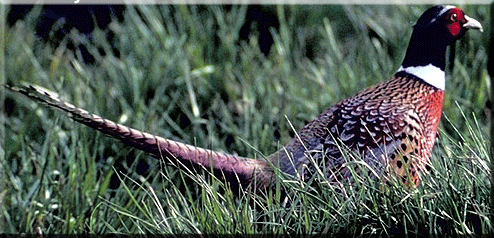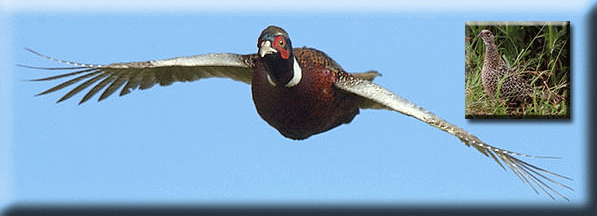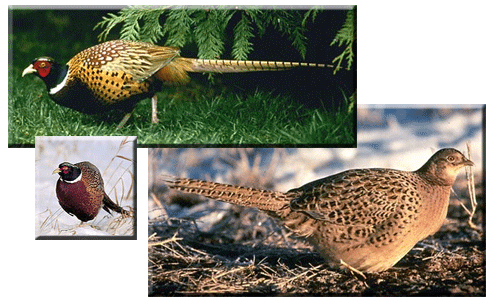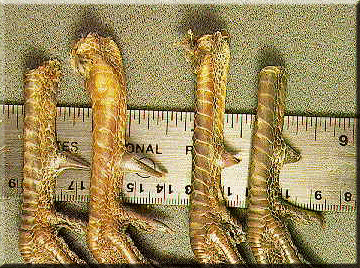
Rooster Pheasant
Upland Game Identification

Identification Tips:
Length: 27 inches
Chunky, long-tailed, round-winged, ground-dwelling bird
Small head and thin neck
Immatures similar to adult female
Some subspecies have green body or white wings, but are very locally introduced
Adult male:
Green head
Pale bill
Unfeathered red facial skin around eye
White ring around neck
Golden plumage with bluish and greenish iridescence and black spots scattered throughout
Long, pointed, golden tail feathers with black barring
Spurred legs
Adult female:
Buffy brown head and underparts
Dark brown back with paler edgings and centers
Black spots and bars scattered about head, neck and flanks
Long, buff-brown, pointed tail
Lacks spurs
Similar species:
Adult male unmistakable. Female similar to a number of species of female grouse but has a much longer, pointed tail and bare legs. Female Sharp-tailed Grouse also has a pointed tail but is shorter-necked, has a slight crest, has white outer tail feathers, a shorter tail and feathered legs. Female Sage Grouse has a dark belly patch and feathered legs.
Prime pheasant habitat is farmland that has occasional weed fields; blackberry, sumac and honeysuckle patches; swamp edges and marshy depressions grown up in cattails, grass and sedge; and overgrown drainage ditches. Clean-farming practices, where every bit of ground is put into production, can reduce the diversity of food and cover which pheasants prefer.
 Winter food and cover are important to local pheasant populations. Good foods are thorn apples, apples, rose hips, skunk cabbage, ragweed, burdock, grapes, grasses, green vegetation and Japanese barberry; these, along with grain (especially waste corn left by mechanical harvesters) help birds overwinter. Pheasants locate food in areas melted or blown free of snow, or by scratching. Pines provide excellent cover for roosting and daytime resting. Pheasants also seek out densely vegetated marsh or creek-side areas during bitter weather.
Winter food and cover are important to local pheasant populations. Good foods are thorn apples, apples, rose hips, skunk cabbage, ragweed, burdock, grapes, grasses, green vegetation and Japanese barberry; these, along with grain (especially waste corn left by mechanical harvesters) help birds overwinter. Pheasants locate food in areas melted or blown free of snow, or by scratching. Pines provide excellent cover for roosting and daytime resting. Pheasants also seek out densely vegetated marsh or creek-side areas during bitter weather.
Farmers can manage their land to produce more pheasants. Strips of corn may be left unharvested (5-10 rows next to cover are adequate); unpicked soybeans make good summer, fall, and winter cover, and the beans are eaten from fall to spring. Forest edges can be cut to increase low, brushy growth, which makes good cover. Autumn olive, honeysuckle and pine plantings also improve cover. However, these things, of themselves, will not increase the pheasant population. Safe nesting cover will. This is the most important factor when bird numbers fluctuate widely from year to year. To reduce nesting losses, farmers should delay their first alfalfa cutting until the end of June.
Given adequate food and protective cover, ringnecks can pull through rough winters. They are hardy birds and, like all wildlife, have keen survival instincts. A hunter needs to know the difference between a hen and rooster pheasant before he or she pulls the trigger. Most of the time, the identity of the bird flushing at your feet is obvious.
There are situations, though, where it is good to hesitate or hold back. Birds flushing into a rising or setting sun are often a tough call. It's not always possible to hunt pheasants with the sun at your back, but it's a good idea.
When your eyes can't make a positive ID on a pheasant, your ears might be able to lend some help. Rooster pheasants often crow or cackle when they launch. Hens are silent except for the rush of their beating wings.

Early in the pheasant season, juvenile roosters can be fully colored or hardly colored at all. Consider the photo below. Both birds were taken on October 10 - opening day of pheasant season - last fall, on adjoining sections of land. Both birds were juveniles, but one was fully colored, the other more closely resembled a hen.

| These two roosters were both taken on October 10, 1992 - opening day of pheasant season last fall - within a mile of each other. Both are young-of-the-year birds. The bottom is obviously a juvnile. The top bird id fully colored. To tell whether the top bird is an adult or juvnile, you need to check the length and apperance of the spurs. |
The latter bird flushed close to the hunter, showing enough color to indicate rooster, but the hunter wasn't positive enough to shoot until the bird made a feeble cackle on its way up.
Identifying the half-colored bird as a juvenile was easy. Adult roosters molt in summer, but they are fully colored again by early fall. The key to determining age between fully-colored juvenile roosters, and adults, is the spur located on each of the pheasant's legs, between the foot and knee.
All rooster pheasants have spurs, while hens don't. That's why a foot left on a dressed pheasant is adequate for determining sex.
Spur length can vary from just a small nub on a very young bird, to more than 3/4 of an inch (including leg bone) on adult birds. The general rule for determining a rooster's age is that if the spur is less than a 3/4-inch in length, including the leg bone, the bird is a young-of-the-year. If the spur is more than 3/4-inch long, including the leg bone, the bird is an adult.
If there is any doubt as to age based on spur length, Game and Fish Department pheasant biologist Lowell Tripp, Oakes, says spur appearance is the deciding factor. If the spur is dull-colored, and the point is blunt and soft, the bird is a juvenile. If the spur is black, shiny and sharply pointed, the bird is an adult.

| The spurs on the legs of rooster pheasants are the key to telling whether the bird is a juvenile or adult. In this photo, the two legs on the left came from birds that had survivd at least one winter. The legs on the right came from young-of-the-year birds.
The length of the spur on an adult male pheasant is generally 3/4 of an inch or more, measured from the outside of the leg bone to the tip of the spur. Adult spurs are also usually shiny black and sharply pointed. Juvenile roosters have spurs that are less than 3/4 of an inch, measured from the outside of the leg bone to the tip of the spur. Juvenile spurs have soft blunt points and dull coloration. |
In a normal fall, even without looking at the spur, a hunter has an 80 percent chance of guessing whether a rooster in the bag is a young-of-the-year or an adult. That's because, according to Tripp, in an average year about 80 percent of the pheasant bag is juvenile birds. Early in the season the ratio of juvenile to adult birds is even higher, up to 90 percent, Tripp said. Later in the season the harvest might include only 70 percent juveniles.
Biologists do not use pheasant wings to determine whether a bird is a juvenile or adult. Both juvenile and adult pheasants molt all their primary wing feathers each year, Tripp said, so the appearance or growth stages of the primaries can not be used to separate young and adult birds. However, pheasant hunters do send in wings along with legs. Tripp measures the growth of the primaries to determine the age (in weeks) of juvenile birds.